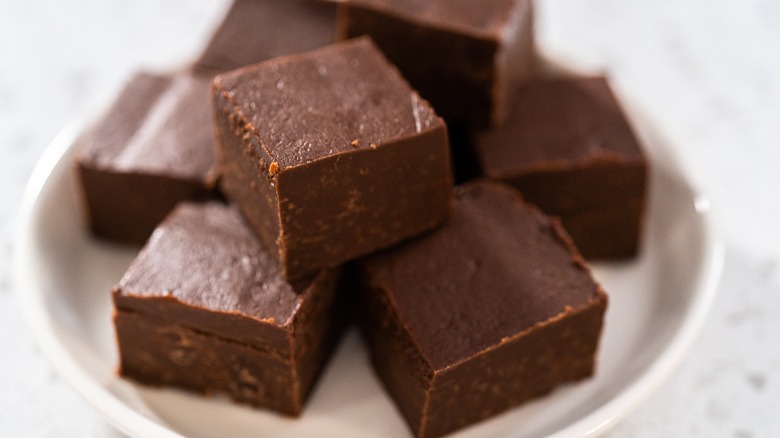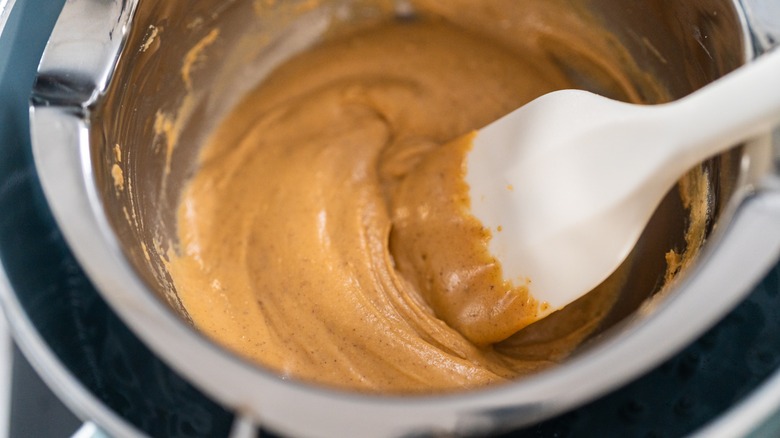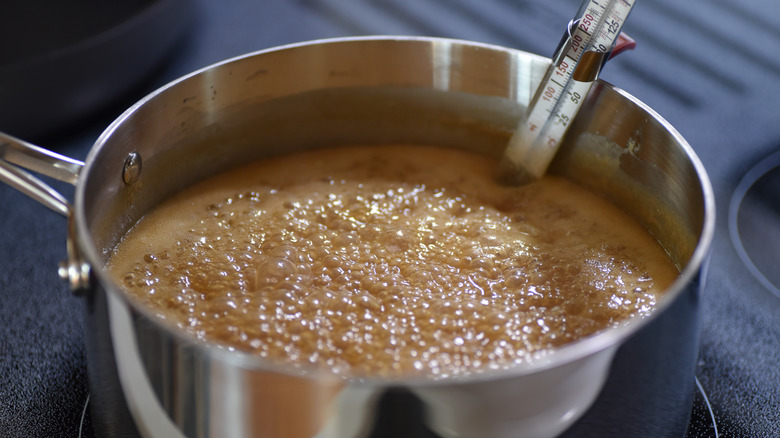How To Fix Homemade Fudge If It Comes Out Grainy
Despite seeming like a relatively simple project on paper, the process of making fudge at home can be a tricky thing. Melting a ton of sugar and dairy shouldn't be difficult, but one wrong move might land you with only a batch of grainy fudge to show for all your hard work. Thankfully, this grittiness doesn't mean your fudge is permanently ruined — all you have to do to rescue grainy homemade fudge is to set it back on the stove with some extra liquid and care.
When it comes down to it, those coarse bits in your fudge are just the sugars that have crystallized instead of setting into a smooth consistency as the mixture was cooling down. Graining can be caused by stirring the fudge mixture during the cooling process or not adding enough fluid to dissolve the sugar. The trick to fixing graininess is to melt the sugar crystals to give them another chance at setting properly. Just add a little liquid to make sure the mixture doesn't burn while you try to reset the crystals.
Take extra care when melting fudge a second time
The first step is to return the fudge to the pan and over the stovetop on a low heat setting. Stir in a bit of water or cream — the amount you need will vary based on how big a batch you're making, but a half cup of liquid should be a good starting point. Stir gently as the mixture reheats, making sure that you don't burn the fudge. If you have a candy thermometer, bust it out so you can keep an eye on the heat as you wait for the grainy consistency to melt down.
One thing to note is that, as you're re-melting the fudge, it's important to scrape or wash down the sides of the pot to ensure that all of the grainy batch melts. The tricky part about crystallized ingredients is that any remaining crystals can cause the rest of the mixture to seize up and crystallize again. So be especially careful to get rid of any remaining graininess in your fudge to prevent it from getting gritty all over again.
Once it melts to a smooth consistency, all that's left is to restart the fudge-making process from boiling the mixture. This time you should take extra care not to stir or beat the fudge before it cools down to the temperature outlined in the recipe, as premature stirring is one of the most common causes of grainy fudge.
Other things to keep in mind when fixing fudge
The downside to the reheating process is that the extra added liquid inevitably dilutes the fudge mixture. One way to mitigate this is to do a few taste tests during the melting phase before it boils, adding extra portions of ingredients to reinforce the flavor as you go. But take care because the mixture will be blazing hot!
Ideally, it should only take one reheating to fix your fudge. Repeated rescue attempts entail more dilution and increased chances of burning your fudge and should be avoided as much as possible. If your grainy fudge is giving you extra trouble despite your best efforts, there is a way to make the process a little more foolproof: Add some cream of tartar to the mix. While this might seem counter-intuitive if you're used to using cream of tartar to help stiffen baking mixtures, the acid in the powder helps inhibit sugar crystal formation and lends itself to a smoother texture.
But with all that said, it's important to remember that the best and most foolproof approach to fixing grainy fudge is to prevent it before it happens. So next time you whip up a batch of fudge, follow the recipe instructions carefully, use a candy thermometer if possible, and avoid stirring once the mixture is boiling to minimize the risk of crystallization.


